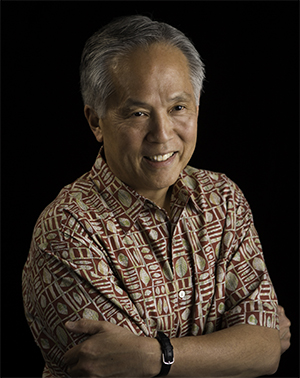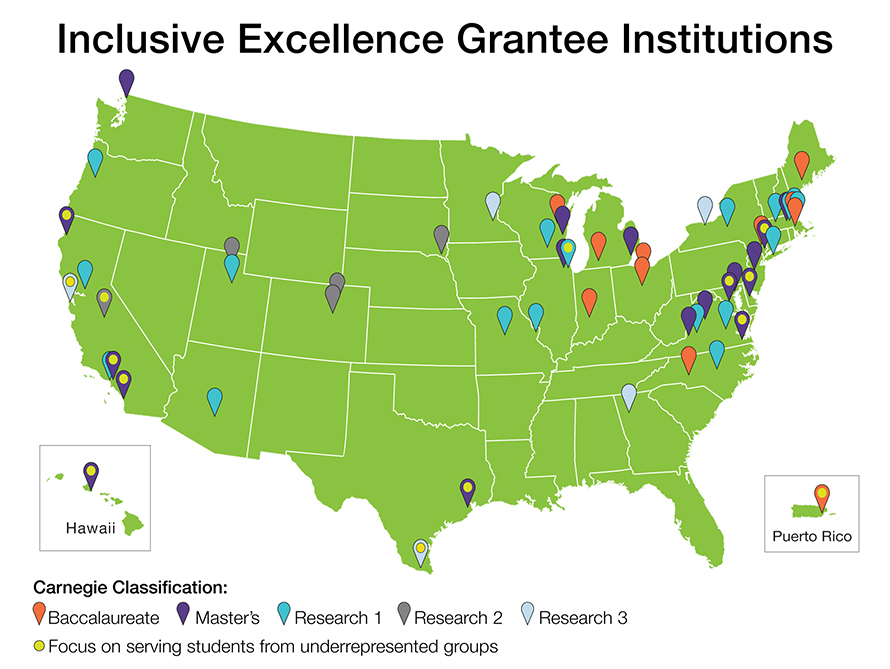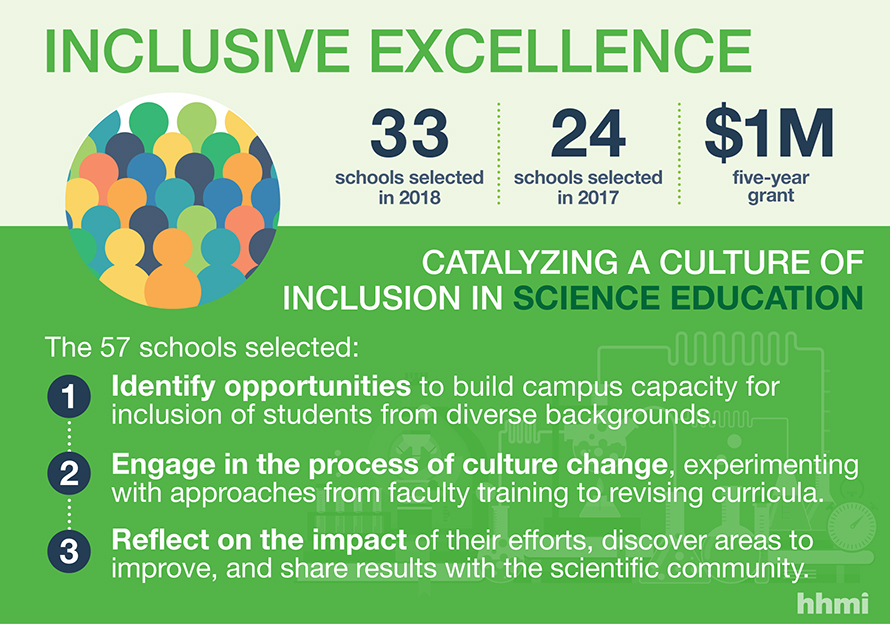Inclusive Excellence aims
at lasting change
The scientific community now recognizes that diversity is important, yet historical exclusion of certain groups from the sciences hinders inclusivity and growth. This limits the range of perspectives within the community, which then loses this benefit of diversity.

Funding agencies have developed programs to increase diversity in science. But David Asai, senior director of science education for the Howard Hughes Medical Institute, thinks more needs to be done.
“These efforts have had a positive effect,” Asai said, “but our overall progress has been appallingly inadequate.”
This is partially due to a long-standing focus on students without a corresponding focus on the learning environment in which the students find themselves, Asai said. Many programs provide tutoring, mentoring and research experiences for specific groups of students without altering the academic structures in their schools or universities.
“While these ‘fix the student’ interventions might help the students who participate, they generally do not result in lasting change,” Asai said. “When the grant ends, the activities end, and the system goes back to where it was before.”
To overcome these limitations, the HHMI conceived a new approach to increase diversity in the sciences: the Inclusive Excellence initiative. Launched in 2015, this initiative provides grants to colleges and universities that are working to achieve significant and sustained increases in their inclusivity of all students.
Each participating school is asked to think about the populations of students that may be excluded at their institution. These may include students from racial and ethnic groups historically excluded from science, students transferring from community colleges and those that are the first generation in their families to attend college. Instead of a student-centric approach, the Inclusive Excellence initiative is focused on the institution itself.

“This approach emphasizes the building of significant and lasting changes in the institution’s capacity for inclusion,” Asai said.
Colleges and universities can apply to be a part of the initiative, and Asai said interest is high. In 2017, the 24 schools in the first cohort were awarded $1 million each in grant funding over five years to support institutional-level changes that create an inclusive culture for all students.
The schools work in collaboration with the HHMI and the Association of American Colleges and Universities to enact these changes. The second round of awards went to 33 schools in 2018, and the application process is under way for the next round, called IE3.
Specific programs and implementation plans vary among institutions based on their needs and goals, and a single school may have multiple initiatives. For example, several schools, including the University of Wisconsin-Madison, Framingham State and the University of Utah, are working with nearby community colleges to align their curricula and advising so that students transferring into four-year universities can be successful in science, technology, engineering and mathematics studies.
Kenyon College and others connect inclusive behaviors in the ways faculty do their jobs, such as the way they teach and advise, to faculty rewards systems, including tenure, to provide incentives for conscious inclusive efforts. Still other schools are revising their introductory science curriculums to include course-based research experiences for beginning science students, as is the case at Towson University and Norfolk State. Inclusive Excellence allows schools to be creative and individualized with their approaches as long as they are striving for increased inclusivity and lasting change.
Institutions submit proposals that are reviewed by HHMI staff as well as scientists and educators who provide advice to the HHMI review panel during the application process. Preproposals for the IE3 cycle were due Jan. 14, and more than 400 schools indicated that they intended to apply; up to 30 will be awarded grants.
The Inclusive Excellence initiative is relatively new, but Asai said HHMI staff members already have gained insight about what it takes to create meaningful culture change in an institution.
“Working toward inclusive excellence is a never-ending process, and the process is dynamic,” Asai said. “The institutional context changes all the time, often unexpectedly, and the work toward inclusive excellence must navigate these changes.”
The lessons of the first two rounds will help the HHMI improve the program and other inclusivity efforts including their recently announced Driving Change program.
For the learning community to improve as a whole, Asai said, its members need to reflect on and share their experiences. For example, each grantee institution is part of a small peer implementation cluster, typically composed of four schools, that meets regularly. During these sessions, groups of faculty and staff from each Inclusive Excellence school share with one another what they are learning and how they can improve further. As an increasing number of schools become involved in the Inclusive Excellence learning community, this mutual support will help promote lasting and meaningful change.

Driving Change
The Howard Hughes Medical Institute launched a new initiative, Driving Change, in 2019 to promote a comprehensive approach to diversity and inclusion at research universities.
Each Driving Change university is expected to achieve three objectives:
- Learn about the Meyerhoff Scholars Program at the University of Maryland, Baltimore County, and design their own student-centered program that will honor the underlying values of and achieve the outcomes of the Meyerhoff Program.
- Design, implement and assess programs aimed at creating a significantly more inclusive learning environment for all students, especially with an eye toward closing the disparity gaps between students from excluded and nonexcluded groups.
- Become an active participant in a learning community comprising other Driving Change universities in which the schools will share their ideas, efforts and outcomes.
Each school applying for a Driving Change grant will conduct a self-study to identify how it can create a more inclusive STEM learning environment. Letters of intent for the first round of grants are due Feb. 7.
Enjoy reading ASBMB Today?
Become a member to receive the print edition four times a year and the digital edition monthly.
Learn moreFeatured jobs
from the ASBMB career center
Get the latest from ASBMB Today
Enter your email address, and we’ll send you a weekly email with recent articles, interviews and more.
Latest in Careers
Careers highlights or most popular articles

Building the blueprint to block HIV
Wesley Sundquist will present his work on the HIV capsid and revolutionary drug, Lenacapavir, at the ASBMB Annual Meeting, March 7–10, in Maryland.

Upcoming opportunities
Present your research alongside other outstanding scientists. The #ASBMB26 late-breaking abstract deadline is Jan. 15.

Designing life’s building blocks with AI
Tanja Kortemme, a professor at the University of California, San Francisco, will discuss her research using computational biology to engineer proteins at the 2026 ASBMB Annual Meeting.

Upcoming opportunities
#ASBMB26 late-breaking abstract submission opens on December 8. Register by Jan. 15 to get the early rate on our Annual Meeting.

Make your abstract stand out
Ensure your research is impossible to overlook. Get quick, practical reminders for crafting an abstract that attracts readers and helps you build connections at the conference.

Inside industry postdocs
As more Ph.D. scientists look beyond academia, industry postdocs offer a new kind of training, where mentorship meets mission-driven research. Fellows at Pfizer and Genentech share how these programs prepare them to translate discovery into impact.

